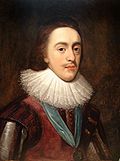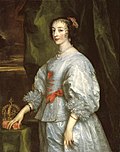Charles I of England
Charles I (19 November 1600 – 30 January 1649),[1] was the king of England, Scotland, and Ireland from 27 March 1625 until his execution in 1649.[2] He was a son of James VI and I. He was married to Henrietta Maria of France. He was executed during the English Civil War.
| Charles I | |
|---|---|
 Portrait from the studio of Anthony van Dyck, 1636 | |
| King of England and Ireland (more...) | |
| 27 March 1625 – 30 January 1649 | |
| 2 February 1626 | |
| Predecessor | James I |
| Successor |
|
| King of Scotland (more...) | |
| 27 March 1625 – 30 January 1649 | |
| Coronation | 18 June 1633 |
| Predecessor | James VI |
| Successor | Charles II |
| Born | 19 November 1600 Dunfermline Palace, Dunfermline, Scotland |
| Died | 30 January 1649 (aged 48) Whitehall, London, England |
| Burial | 9 February 1649 St George's Chapel, Windsor Castle, England |
| Spouse | |
| Issue Detail |
|
| House | Stuart |
| Father | James VI of Scotland and I of England |
| Mother | Anne of Denmark |
| Religion | Anglican |
Early life
Charles was born at Dunfermline Palace in Fife, Scotland, before his father James VI and I came to the throne of England.
Charles came to England in 1604. When Charles's older brother Henry Frederick died in 1612, Charles became the Prince of Wales and the heir apparent to his father's kingdoms.[3] He had an elder brother, Henry, who was clever, handsome, popular, and rich, and next in line for the throne. Henry died suddenly in 1612, and then his brother Charles was made Prince of Wales in his place, showing that he was now the heir to the throne. Charles was less suited to be king than Henry had been, because he was small and weak and not as clever.
After his brother died, the person Charles was closest to was George Villiers, Duke of Buckingham, who was also his father's best friend. The Duke of Buckingham was very powerful and rich, but was not popular with most common people. He took Charles to Spain in the hope of finding him a Spanish princess as a bride, but they had a lot of problems on the journey and could not persuade the Spanish king to give them his daughter as a wife for Charles.
Charles sat in the Parliament of England's House of Lords in 1621. King James wanted Charles to marry Maria Anna of Spain because she was the sister of Philip IV of Spain. Charles travelled to Spain to meet Maria in 1623, but the journey was a disaster, the two did not marry, and Charles became an enemy of Spain.[3]
On the way home, Charles went through France again, and there Charles met the French royal family.
Charles married Henrietta Maria of France because she was the sister of the French king, Louis XIII, and planned to fight Spain. The Parliament of England convened in 1624 because of Charles's plans. King James did not want a war, but he died in 1625.[3]
Charles' religion
His religious policies, and his marriage to a Roman Catholic, made him mistrusted by Reformed groups such as the English Puritans and Scottish Covenanters, who thought his views were too Catholic. He supported "high church" Anglican ecclesiastics, and failed to help Protestant forces enough in the Thirty Years' War. His attempts to force the Church of Scotland to adopt high Anglican practices strengthened the position of the English and Scottish parliaments and were a cause of his downfall.
King
Charles, now the king, convened the parliament again in 1625. The parliament did not give the king what the king wanted. The men in parliament did not like Charles's friend George Villiers, 1st Duke of Buckingham. Buckingham had gone with Charles to Spain and later helped him to marry Henrietta Maria. When Buckingham led the Royal Navy to attack Cadiz in Spain, the campaign was a failure, and the Parliament of England impeached him. Because of this, Charles stopped (dissolved) the parliament. He also wanted to send soldiers to help Protestants in the Kingdom of France, and made demands for more money as payment for the army. This campaign was also a failure, and the king had to agree to the Petition of Right in 1628. An army officer assassinated Buckingham that summer.[3]
The Parliament of England convened again in 1629. There were many disagreements about religion and the organization of the Church of England. Charles gave support to the "High Church" group, but the parliament gave their support to the "Low Church" group. Charles supported Arminianism, but the parliament's House of Commons tried to make Arminianism illegal. To stop the House of Commons, the king again dissolved the parliament. Some members of parliament in the House of Commons tried to continue their session, but the king put them in prison. Charles continued to support Arminians in the Church of England, with the inclusion of William Laud, the Archbishop of Canterbury (the chief bishop of all England). The population disliked Laud and the Arminians, and disliked Charles's taxes. Between 1629 and 1640, the king controlled the government alone. There was no parliament. This time has the name "Personal Rule" or the "Eleven Years' Tyranny".[3]
This made Charles very unpopular with the people, who did not like the different taxes they had to pay directly to the king, since Parliament could not vote to give him any budget. Many also did not like the King's closest adviser, William Laud, who was trying to force the Church of England to use the same Anglican Prayer Book and stop the many other Protestant denominations that were becoming popular at that time.
When the king and the Archbishop then tried to force a Prayer Book on Scotland, which was even more Protestant (Calvinist), armed rebellion broke out there. The Wars of the Three Kingdoms started in 1639 with the Bishops' Wars.[3]
The members of Parliament, angry at the things that had been going on for 11 years, did not want to give him money to fight his war. Instead, they spent the session complaining about what had been going on in the country for the last 11 years. So after only three weeks, Charles dissolved Parliament again. For this reason, it was known as the Short Parliament. Without enough money, Charles lost the war badly, and had to pay the Scots even more money that he did not have.
These wars were a failure for the king, and his position forced Charles to convene the Parliament of England in 1640.[3] Parliament voted that the King had to call Parliament, and could not shut them down again. Charles had no choice but to agree. This Parliament is known as the Long Parliament, because it ended up lasting for twenty years, until 1660.
Charles was in a weak position, and he had to agree to acts of parliament that took away many of his royal powers.[3] Laud and Thomas Wentworth, 1st Earl of Strafford were both impeached and later were executed. Parliament also tried to take control of the army away from the king. Many political conservatives were not pleased with this plan. Acting on the advice of his wife Queen Maria Henrietta, the king went with soldiers to the House of Commons in 1642 and tried to arrest his political enemies. They had gone. After this failure, the king left London and went to travel the country to look for help. With a collection of his political friends, Charles began the English Civil War with an army at Nottingham, and then moved to Oxford.[3]
The army of Parliament got the upper hand in this war, and Charles, after a crushing defeat in 1646, went to the Scots for protection. They decided to hand him over to the Parliament of England in 1647.
The war was a failure for the king, and Charles was made a prisoner.[3] The king got out of Hampton Court Palace in 1647 and ran away to Carisbrooke Castle, on the Isle of Wight.[3]
The governor of the Isle of Wight was on the side of Parliament and made the king a prisoner again. While he was being held at Carisbrooke Castle, Charles made an agreement with the Scots who joined his side, and the fighting started again in 1648.
Charles's many enemies then fought among themselves in spring 1648.[3] Because he was still making trouble for them even while he was captured, Parliament voted to put the king on trial.
The army then removed the conservatives from parliament in a political purge in December as an insurance against more fighting. The men left in parliament then formed a court in order to hold a trial of the king. The court gave the king the death penalty.[3] This had never been done to a king of England before.
Children
| Name | Birth | Death | Notes |
|---|---|---|---|
| Charles James, Duke of Cornwall | 13 March 1627 | 13 March 1627 | Stillborn; unknown burial site. |
| Charles II | 29 May 1630 | 6 February 1685 | Married Catherine of Braganza (1638–1705) in 1663. No legitimate children. |
| Mary, Princess Royal | 4 November 1631 | 24 December 1660 | Married William II, Prince of Orange (1626–1650) in 1641. Had children. |
| James II, King of England | 14 October 1633 | 16 September 1701 | Married (1) Anne Hyde (1637–1671) in 1659; had children (2) Mary of Modena (1658–1718) in 1673; had children |
| Elizabeth, Princess of England | 29 December 1635 | 8 September 1650 | Died young; no children. Buried Newport, Isle of Wight |
| Anne, Princess of England | 17 March 1637 | 8 December 1640 | Died young; no children. Buried Westminster Abbey |
| Catherine, Princess of England | 29 January 1639 | 29 January 1639 | Stillborn; buried Westminster Abbey. |
| Henry, Duke of Gloucester | 8 July 1640 | 18 September 1660 | Died unmarried; no children. Buried Westminster Abbey |
| Henrietta, Princess of England | 16 June 1644 | 30 June 1670 | Married Philippe de France, Duke of Orléans (1640–1701) in 1662; had children |
Death
At the trial he was found guilty. He was decapitated in a public execution outside the Banqueting House of the palace at Whitehall.[3] Some of the members of Parliament who were opposed to killing king Charles were purged, and from this time on, what was left of the Long Parliament became known as the Rump Parliament. This Parliament took complete power in England, and there was not a new king at all until 1660.
Charles I Of England Media
Engraving by Simon de Passe of Charles and his parents, King James and Queen Anne, c. 1612
Portrait by Robert Peake the Elder, c. 1611
Portrait of Charles as Prince of Wales after Daniel Mytens, c. 1623
Queen Henrietta Maria by van Dyck, 1632
Portrait by Gerrit van Honthorst, 1628
Sixpence of Charles I, inscribed: CAROLUS D(EI) G(RATIA) MAG(NAE) BRIT(ANNIAE) FR(ANCIAE) ET HIB(ERNIAE) REX ("Charles, by the grace of God, King of Great Britain, of France and of Ireland")
Charles with paned sleeves, by Daniel Mytens c. 1631.
References
- ↑ "Charles I of England". BBC. Retrieved 2011-04-20.
- ↑ information Britain, 2008, retrieved 2010-03-19
- ↑ 3.00 3.01 3.02 3.03 3.04 3.05 3.06 3.07 3.08 3.09 3.10 3.11 3.12 3.13 Cannon, John; Crowcroft, Robert (2015). "Charles I". A Dictionary of British History (3rd ed.). Oxford University Press. doi:10.1093/acref/9780191758027.001.0001. ISBN 978-0-19-175802-7.
- ↑ Weightman 1906, p. 185.









